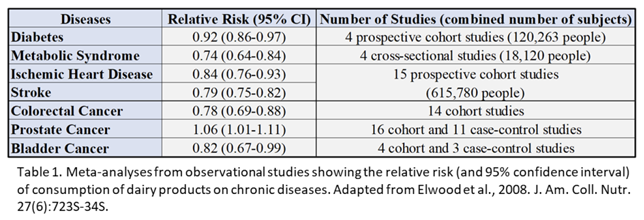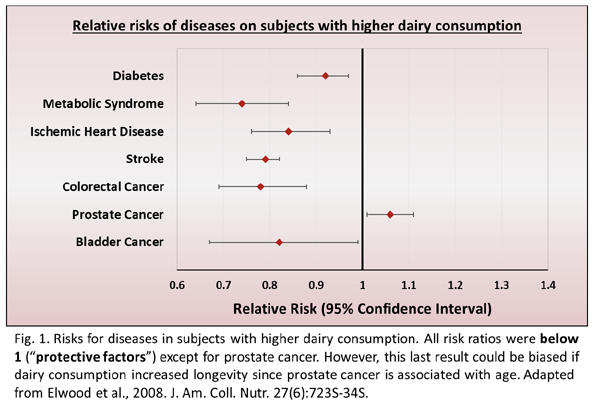Jennifer A. Spencer, Ph.D. and Juan Piñeiro, DVM, Ph.D. Texas A&M AgriLife Extension Service
Scientific evidence suggests that consuming dairy products is associated with decreased risk for obesity, Type 2 diabetes, cardiovascular disease and some types of cancer1,2. Most of these studies have searched, evaluated, selected, summarized, and performed meta-analyses of several observational studies. While randomized experiments would be best to test the health benefits of consuming dairy products, it might not be feasible to perform them. There are several factors that lower the risk of chronic diseases (e.g., exercise). However, this article will discuss the effect consuming dairy products may have on decreasing the risk of chronic diseases and the importance on human health.
Consumption of dairy products decreases the risk of chronic diseases
Researchers suggest consuming milk and dairy foods might provide a survival advantage, based on the effects of consumption decreasing the risk of chronic diseases1. In 2017, among the top 10 leading causes of death in the U.S., heart diseases, 23%; cancer, 21%; strokes, 5%; and diabetes, 3%, accounted for over half of the leading causes of total deaths3.
Meta-analyses of over 70 studies found that people who consumed more dairy products had a relative risk <1 for most chronic diseases1. This means that consuming dairy products acts as a protective factor for chronic diseases.
How do we interpret relative risks –RR–?
- RR<1, the outcome, or chronic disease in this case, is less likely to occur if there was exposure, or consuming dairy foods. These are known as “protective factors.”
- RR=1, there is no association between the outcome and the exposure.
- RR>1, the outcome is more likely to occur if the exposure was present.
Table 1 summarizes the results of these meta-analyses –RR with 95% confidence intervals–, the number of studies used, and the total number of subjects. Higher
consumption of dairy products was a protective factor for diabetes, metabolic syndrome – i.e., raised levels of blood glucose and lipids, body fat and blood pressure–, heart disease, stroke, colorectal cancer, and bladder cancer(1).

The only exception was prostate cancer; consuming dairy products had a small effect in increasing the risk of developing the disease1 (Figure 1). However, this could be biased if consuming dairy products increased the longevity of men involved in these studies, since prostate cancer is associated with age. This would make sense, considering that consuming dairy foods is a protective factor for chronic diseases that caused roughly half of U.S. deaths in 2017(3).

Why dairy consumption decreases the risk of chronic diseases?
The mechanisms underlying the effect of dairy foods consumption on decreased risk of chronic diseases have not been clearly defined. However, recent research suggests that dairy foods may help to regulate appetite, stimulate weight loss and prevent weight gain2. This might partially explain why consuming dairy products would decrease chronic diseases for which being overweight and obesity are risk factors, such as Type 2 diabetes, cardiovascular diseases, etc.
Potential mechanisms may involve calcium’s ability to reduce fat absorption due to formation of calcium soaps with fat in the intestine and increase fecal fat excretion, increase break down of body fat, and decrease the formation and storage of body fat. In addition, lactose, milk proteins –especially whey proteins– and peptides derived from protein’s digestion may regulate food intake and decrease appetite. Lastly, medium chain fatty acids present in milk reduce body fat generation and storage2.
In conclusion, these data suggest that dairy foods are not just a great source of high-quality protein, calcium, potassium, iodine, and vitamins A, D and B (B2, B3, B12); its consumption could decrease the risk of chronic diseases.
Source: Texas A&M Extension









